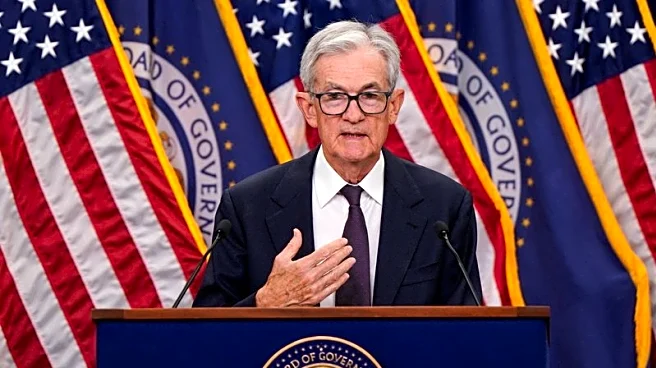What's Happening?
Gold prices experienced a slight decline on Friday following the release of stronger-than-expected U.S. economic data, which has cast doubt on the Federal Reserve's potential rate cut outlook. This development has bolstered the U.S. dollar, making gold more expensive for international buyers. Spot gold fell by 0.2% to $3,741.21 per ounce, although it has seen a 1.6% increase over the week. U.S. gold futures for December delivery remained unchanged at $3,771.30. The U.S. dollar index is near a three-week high, influenced by President Trump's recent announcement of new tariffs on imported goods starting October 1. Additionally, U.S. jobless claims have declined, and the second-quarter GDP grew faster than expected due to strong consumer spending and business investment. The market is now focused on the upcoming personal consumption expenditures (PCE) price index data, the Federal Reserve's preferred inflation measure, which is anticipated to show a 0.3% month-on-month rise and a 2.7% year-on-year increase for August.
Why It's Important?
The strengthening of the U.S. dollar and the subsequent impact on gold prices highlight the interconnectedness of economic indicators and market reactions. A stronger dollar typically makes dollar-priced commodities like gold more expensive for foreign buyers, potentially reducing demand. The anticipation surrounding the PCE price index data is significant as it could influence the Federal Reserve's monetary policy decisions, particularly regarding interest rates. Lower interest rates generally benefit gold as a non-yielding asset, making it more attractive in a low-interest-rate environment. The recent economic data, including GDP growth and jobless claims, suggests a robust U.S. economy, which could lead to a reassessment of rate cut expectations. This situation presents a complex scenario for investors, balancing between economic growth indicators and inflation concerns.
What's Next?
Market participants are closely monitoring the release of the PCE price index data, which could provide further insights into inflation trends and influence the Federal Reserve's policy decisions. If the inflation data aligns with expectations, it may reinforce the current economic outlook and impact future rate cut considerations. Investors will also be watching for any additional policy announcements from the Federal Reserve, particularly in response to President Trump's tariff measures and their potential inflationary effects. The interplay between economic data, monetary policy, and geopolitical developments will continue to shape market dynamics, affecting commodities like gold and the broader financial landscape.
Beyond the Headlines
The recent developments underscore the broader implications of economic policy and international trade decisions on financial markets. President Trump's tariff announcements could have long-term effects on trade relations and economic growth, influencing inflation and monetary policy. The Federal Reserve's approach to balancing economic growth with inflation control will be crucial in maintaining market stability. Additionally, the role of safe-haven assets like gold in times of economic uncertainty remains a key consideration for investors, reflecting broader concerns about global economic conditions and geopolitical tensions.











